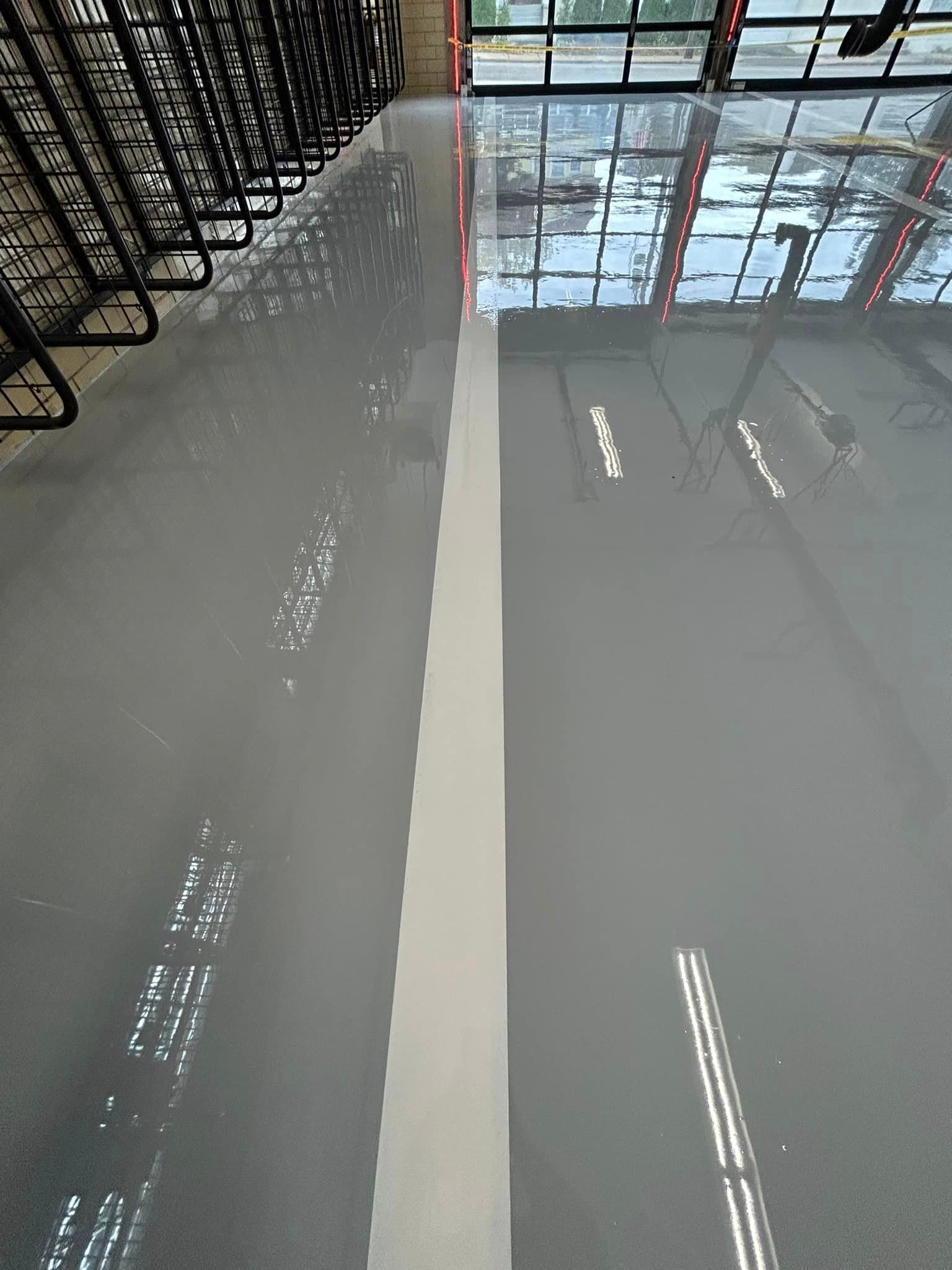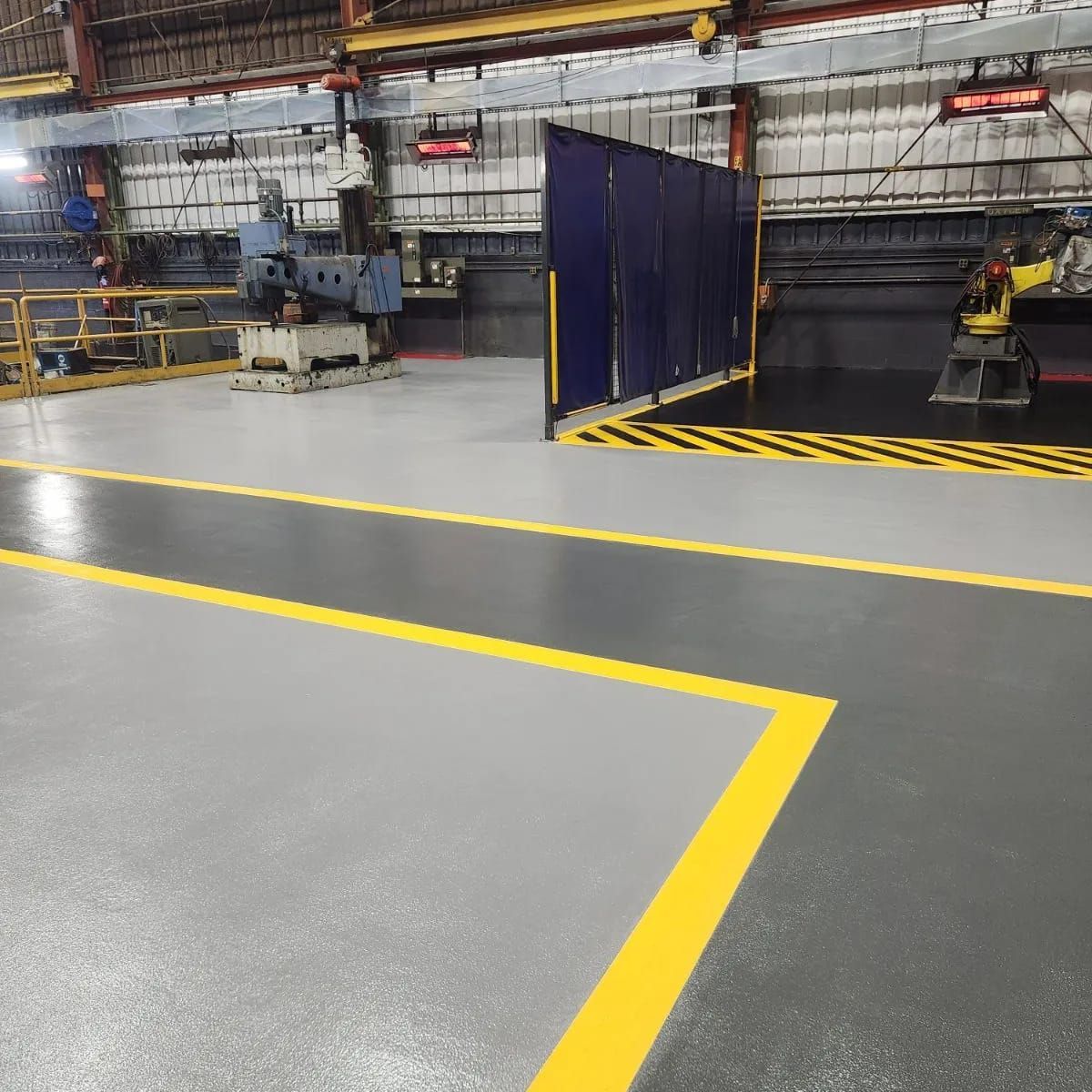Security Lines System
Security lines are an essential component of epoxy flooring systems, designed to enhance safety, organization, and efficiency in various environments. These visual markers play a crucial role in guiding traffic, delineating spaces, and ensuring compliance with safety regulations.
Get Your Quote Now
Contact Us
Security lines in epoxy flooring refer to painted or embedded linear markings that are integrated into the floor surface. These lines are typically made using durable epoxy materials that bond seamlessly with the existing flooring, creating long-lasting and highly visible indicators.
Advantages of Epoxy Security Lines
The primary purpose of security lines is to improve safety and organization within a space. They serve as visual cues to direct foot and vehicle traffic, separate different areas, highlight potential hazards, and enforce safety protocols. By clearly defining boundaries and pathways, security lines help reduce accidents, improve workflow, and enhance overall operational efficiency.

Types of Security Lines
Solid lines: Continuous, unbroken lines used for definitive boundaries or strict separations.
Dashed lines: Intermittent markings often used to indicate flexible boundaries or temporary divisions.
Textured lines: Lines with raised or embossed surfaces that provide both visual and tactile feedback.
Glow-in-the-dark lines: Photoluminescent markings that remain visible in low-light conditions or power outages.
Applications of Security Lines
Security lines find widespread use across various settings, enhancing safety, organization, and efficiency in each unique environment.
Industrial settings
- Factories: Security lines demarcate assembly lines, robotic work cells, and pedestrian walkways to prevent accidents and optimize workflow.
- Warehouses: Lines define aisles, storage areas, loading docks, and forklift paths, improving inventory management and reducing collision risks.
- Production facilities: Lines separate different production stages, highlight emergency exits, and mark areas around hazardous machinery or materials.
Commercial spaces:
- Retail stores: Security lines guide customer traffic flow, define queuing areas, and mark restricted zones like stockrooms or employee-only sections.
- Offices: Lines delineate individual workstations, collaborative spaces, and pathways in open-plan layouts, enhancing spatial organization.
- Public buildings: Museums, libraries, and government facilities use lines to manage visitor flow, indicate exhibit boundaries, and mark security checkpoints.
Parking garages
- Parking space delineation: Clear lines mark individual parking spots, including specialized areas for disabled parking, electric vehicle charging, and compact cars.
- Traffic flow indicators: Arrows and lines guide drivers through entry and exit points, up and down ramps, and around corners.
- Pedestrian safety: Crosswalks and walkways are clearly marked to ensure pedestrian safety in areas with vehicle traffic.
Healthcare facilities
- Hospitals: Lines designate clean zones, contamination control areas, and paths for patient transport. They also mark boundaries around sensitive medical equipment.
- Clinics: Security lines guide patient flow from reception to waiting areas and examination rooms, improving efficiency and reducing confusion.
- Laboratories: Lines define workstations, equipment placement, and safety shower locations, crucial for maintaining a safe and organized research environment.
Educational institutions
- Schools: Lines in hallways help manage student traffic between classes, mark emergency exit routes, and define play areas in gymnasiums.
- Universities: Large campuses use lines to guide students through buildings, mark study areas in libraries, and organize laboratory spaces.
Transportation hubs
- Airports: Security lines guide passengers through check-in, security screening, and boarding areas, while also marking taxiways and parking areas for aircraft.
- Train stations: Lines direct passenger flow, mark platform edges for safety, and indicate waiting areas.
Sports and recreational facilities
- Gymnasiums: Lines mark court boundaries for various sports and define spectator areas.
- Swimming pools: Security lines indicate depth changes, lane divisions, and no-diving zones.
Benefits of Security Lines
- Enhanced safety: Clearly marked areas reduce the risk of accidents and injuries.
- Visual guidance: Lines provide intuitive navigation through complex spaces.
- Compliance with regulations: Proper line markings help facilities meet safety standards and requirements.
- Improved traffic flow: Well-designed security lines optimize movement of people and vehicles, increasing efficiency.
Customization Options
Security lines in epoxy flooring offer a wide range of customization options to meet specific needs and aesthetic preferences.
Colors play a crucial role in the effectiveness of these lines, with standard safety colors like yellow, white, and red providing universal recognition. However, custom colors can also be used to match branding or interior design schemes, while high-contrast colors ensure improved visibility in low-light conditions.
The width of security lines can be varied to indicate different levels of importance or types of boundaries, always ensuring compliance with industry standards and local regulations for specific applications.
Patterns add another layer of customization, with solid lines typically used for definitive boundaries, while dashed or dotted lines often indicate flexible or temporary divisions. Chevron patterns can provide directional guidance, and crosshatching is useful for marking special zones or hazard areas.
Integration with other floor markings further enhances the functionality of security lines. This can include combining lines with symbols, text, or pictograms for enhanced communication, incorporating advanced technologies like QR codes or RFID tags for interactive guidance systems, and coordinating with other floor graphics to create a comprehensive wayfinding solution.
These customization options allow for the creation of highly effective and visually appealing security line systems tailored to the unique requirements of each facility.
Frequently Asked Security Line Questions
What are security lines in epoxy flooring?
Security lines are durable, visually distinct markings integrated into epoxy flooring. They are designed to enhance safety, guide traffic flow, and organize spaces in various environments such as industrial facilities, commercial buildings, and healthcare institutions.
How long do security lines in epoxy flooring last?
With proper installation and maintenance, security lines can last as long as the epoxy flooring itself, typically 5-10 years or more, depending on traffic levels and environmental conditions.
Can security lines be applied to existing epoxy floors?
Yes, security lines can be added to existing epoxy floors. However, proper surface preparation is crucial to ensure good adhesion and longevity.
Are security lines slip-resistant?
Security lines can be made slip-resistant by incorporating textured additives or using specialized epoxy formulations designed for improved traction.
Can security lines be removed or changed if needed?
While it's possible to remove or change security lines, it often requires grinding down the existing lines and reapplying new ones. It's best to carefully plan the layout before installation.
Do security lines comply with ADA requirements?
Security lines can be designed to meet ADA requirements. However, specific design elements like contrast ratios and tactile features may need to be incorporated to ensure full compliance.
How do I choose the right colors for my security lines?
Color choice often depends on the specific application, industry standards, and visibility requirements. Yellow and white are common for general use, while red often indicates danger or emergency routes.
How do security lines compare to painted lines in terms of durability?
Epoxy security lines are generally much more durable than painted lines, resisting wear, chemicals, and fading far better, especially in high-traffic or industrial environments.

